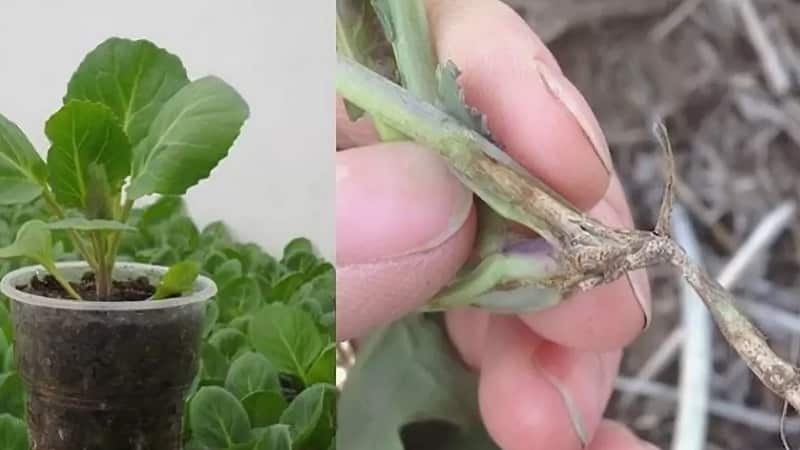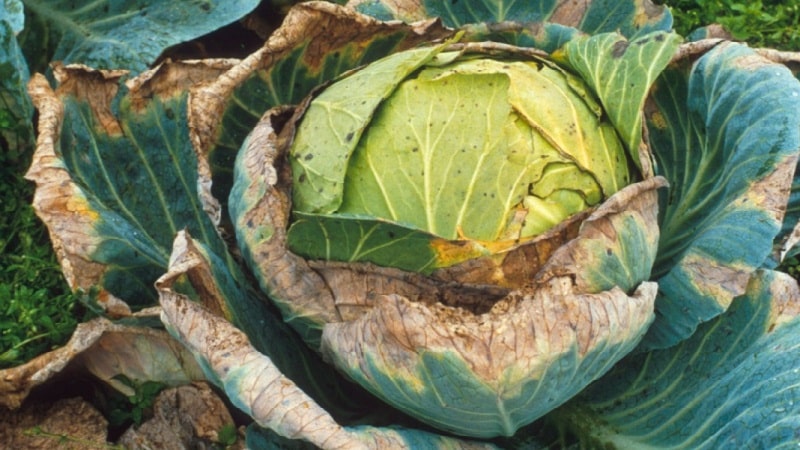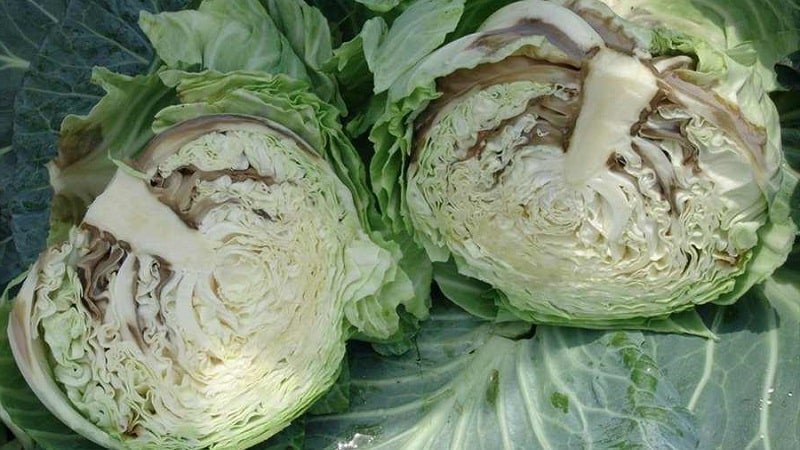What to do when cabbage rots on the vine
White cabbage is considered easy to care for, but sometimes difficulties arise when growing it. Rot on leaves or inside vegetables is a common problem that threatens the entire crop. Let's figure out why cabbage heads rot in the garden and what to do if it was not possible to prevent rotting.
What to do if cabbage rots on the vine
Rotting heads of cabbage occurs for the following reasons::
- non-compliance with plant care rules;
- unfavorable climatic conditions;
- diseases and pests.

Improper agricultural practices stimulate the development of root rot.
When planting cabbage on a plot, it is important to consider the following:
- Follow the planting pattern, maintaining 70–80 cm between heads of cabbage, and 90 cm between rows. This way, formed heads of cabbage will not shade each other and interfere with the development of neighbors.
- Plant the crop in a well-lit area, away from trees, bushes, fences and buildings.
- Avoid the formation of a dry crust on the ground. Loosen the soil after each watering or heavy rainfall so that the roots receive enough oxygen and the moisture does not stagnate.
- Do not plant cabbage in the same place from year to year (take a break for at least 4 years) or after plants, with which she has common diseases (radish, radish).
- Use nitrogenous fertilizers only upon landing. During head development cabbage needs potassium fertilizing.
- Plant plants in soil with neutral or close to neutral acidity levels (pH 6.2–7.5).
- Before planting seeds for seedlings disinfect them: for example, soak them in a weak solution of potassium permanganate.
- Provide plants with drip watering without flooding the outlets.
Note! Most often, it is a violation of agricultural technology that causes cabbage to rot.
When choosing varieties for planting it is advisable to select adapted for cultivation in a specific region. If the summer turns out to be rainy, and the soil does not have time to dry out after precipitation, make a canopy of film over the beds and remove the leaves in contact with the ground. Due to high humidity, rot quickly forms on them, which spreads throughout the plant.
Heat also contributes indirectly to rotting.. Together with high humidity, it creates favorable conditions for the proliferation of pests that damage plants and transmit pathogens.
It is important to carry out timely prevention of pestsusing drugs like “Fitosporin”, “Knockdown”, “Iskra-M” or traditional methods:
- 1 tbsp. pour garlic and onion peels into a bucket of boiling water and leave for 24 hours, strain and use for spraying once a week;
- 1 tbsp. l. Dilute 9% vinegar in a bucket of water, apply once a week, spraying the solution over the plants;
- Once every 2 weeks, dust the cabbage with wood ash.
Gardeners advise planting plants with an insect-repelling odor next to cabbage.: marigolds, garlic, oregano.
Blackleg
A common crop disease that destroys hopes for a good harvest, - black leg.

When cabbage is infected with blackleg, the symptoms are immediately visible: the lower stem darkens and rots. The disease occurs at all stages of crop development.The main reasons include excess nitrogen fertilizers, lack of oxygen and excessive watering.
Attention! Sudden changes in temperature can also provoke the development of blackleg. Therefore, it is important to transfer seedlings to open ground after spring frosts, and when growing in a greenhouse, monitor the temperature and avoid sudden drops.
There are several varieties of white cabbage that are resistant to this disease.: Moskovskaya late 9, Belarusian 455, Amager 611. The drugs “Fitosporin”, “Planriz”, “Baktofit” help fight blackleg.
White rot
Due to prolonged rains, when the weather is humid and the heads of cabbage do not have time to dry out, cabbage is susceptible to this fungal disease. White mucus appears on the upper leaves, and in the voids between them a mycelium develops, gradually approaching the core of the vegetable.

Sometimes the disease develops from below, penetrating into the head of cabbage from the soil along the stem, especially if the size of the plot does not allow changing the location of the cabbage from year to year. Therefore, before placing seedlings in open ground, water the soil generously with boiling water to destroy fungal spores.
Downy mildew
The causative agent of downy mildew waits in the wings in seeds and seedlings; it becomes active later, when the heads of cabbage begin to actively grow. The first signs are yellow spots of irregular shape on the upper leaves. They spread, gradually the leaf dries out and dies. Afterwards, a white powdery coating forms on the cabbage, under which the plant darkens and begins to rot.

To prevent downy mildew, gardeners disinfect seeds before planting. and follow the layout of plants in the garden bed.Plant cabbage in soil cleared of plant residues and disinfected.
Vascular bacteriosis
Develops in regions with warm and humid climates. It appears as darkened vascular veins and black spots on the stem. Because of this, the plant does not receive nutrients from the soil and growth slows down. With vascular bacteriosis, heads of cabbage do not set.

To prevent the disease, thoroughly clean the beds after previous plants. and protecting cabbage from heavy rainfall (for example, by creating a film canopy).
Why does cabbage rot from the stalk?
A dangerous enemy of culture is mucous bacteriosis, or wet rot.. The disease has 2 variants of its course, one of which is the penetration of bacteria through damage to the upper leaves. In this case, microorganisms reach the stalk and soften it, causing the head to fall off.
Several factors provoke the development of wet rot:
- the heads of cabbage were damaged during care;
- the soil is swampy or oversaturated with moisture due to heavy rainfall;
- due to frequent rains, the leaves and head of cabbage are constantly wet;
- plantings are attacked by caterpillars that eat the upper leaves.

More often mucous bacteriosis affects the plant at the second stage of the growing season.
What to do if a head of cabbage rots in the garden
Having noticed signs of rotting cabbage, gardeners do not always know how to save the crop. The algorithm of actions depends on where exactly the rot appears.
In the middle
In this case, it is impossible to save the affected heads of cabbage; the rot will continue to spread. Therefore, they are dug up and burned outside the site, and healthy plants and soil are disinfected. The soil is watered with a 3% solution of copper sulfate. Product consumption - 2 l/m². The drug "Previkur" is also suitable.
Attention! Healthy cabbage is sprayed with Fitosporin.
With mucous bacteriosis, diseased plants are dug up and destroyed, carefully removing plant debris from the beds. The soil is disinfected with a 0.5% solution of potassium permanganate or 3% copper sulfate.
Upper leaves
If putrefactive lesions are noticed on the upper leaves, the plants can still be saved. To do this, diseased cabbage is cut off, the covering leaves are removed, and the heads of cabbage are sent for culinary processing.
If the crop is not yet ripe, diseased plants are left by cutting off the affected leaves. almost at the base. It is important to remove all rotting surface. After this, the cabbage is treated with “Fitosporin”, and the soil under it with “Previkur”.
Conclusion
Cabbage is unpretentious in care and, if agrotechnical practices are followed, produces a rich harvest. However, if you neglect them (choose varieties that are not adapted to the region, do not fight the first manifestations of diseases or pests), the heads of cabbage begin to rot.
Carry out regular preventive care measures, follow planting rules and choose varieties that are resistant to diseases. Then in the fall you will be able to reap a good harvest that will last until spring.